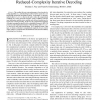Free Online Productivity Tools
i2Speak
i2Symbol
i2OCR
iTex2Img
iWeb2Print
iWeb2Shot
i2Type
iPdf2Split
iPdf2Merge
i2Bopomofo
i2Arabic
i2Style
i2Image
i2PDF
iLatex2Rtf
Sci2ools
JSAC
1998
1998
Early Detection and Trellis Splicing: Reduced-Complexity Iterative Decoding
Abstract—The excellent bit error rate performance of new iterative decoding algorithms (e.g., turbodecoding) is achieved at the expense of a computationally burdensome decoding procedure. In this paper, we present a method called early-detection that can be used to reduce the computational complexity of a variety of iterative decoders. Using a confidence criterion, some information symbols, state variables and codeword symbols are detected early on during decoding. In this way, the computational complexity of further processing is reduced with a controllable increase in BER. We present an easily implemented instance of this algorithm, called trellis splicing, that can be used with turbodecoding. For a simulated system of this type, we obtain a reduction in computational complexity of up to a factor of four, relative to a turbodecoder that obtains the same increase in BER by performing fewer iterations.
Burdensome Decoding Procedure | Computational Complexity | Iterative Decoding Algorithms | JSAC 1998 |
| Added | 22 Dec 2010 |
| Updated | 22 Dec 2010 |
| Type | Journal |
| Year | 1998 |
| Where | JSAC |
| Authors | Brendan J. Frey, Frank R. Kschischang |
Comments (0)

